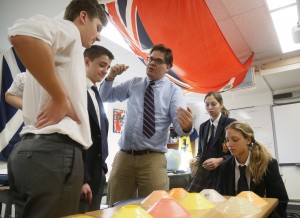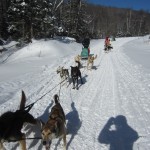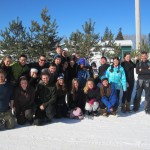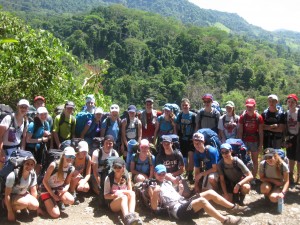
Day 5: Our hiking journey now over, we begin a new chapter. In no time our clothes were going to be washed, our bodies no longer dirty and meals eaten inside at a table. We packed our hiking bags and tents with excitement as in a few hours we would be under a roof for the first time in four days.
We awoke to a beautiful sunrise and ate a delicious breakfast of oatmeal, raisins and granola with hot chocolate. Leaving the campsite was a relief but it was also quite difficult to say goodbye to the beauty of the Costa Rican jungle. Mauricio and his adoptive brother Ura led us to the adventure Center that was also his parents’ home; we followed a narrow path for about half an hour to get there. Mauricio’s family greeted us with open arms. His mother had cooked pancakes on top of which she pored some of her delicious homemade chocolate sauce. Everyone had their own bed and bathrooms were also easily accessible.
We settled in, unpacked and explored our new home. They had many pets including a chicken, a rooster, a grumpy turkey and four dogs. Many of us loved the family’s female dog, Lucky. The house was divided into three areas: the kitchen, the boys’ rooms and the girls’ rooms. All the beds were in bunks and fortunately bugs were not out in force. We were constantly serenaded by the sound of crashing water from the nearby river. Mauricio gave us the opportunity to go swimming in the clear blue water. It was absolutely rejuvenating to swim after our four-day hike even if the water was somewhat chilly.
Meanwhile, Mauricio’s mother Rosa was cooking us lunch; she made rice, beans, chicken and more pancakes with chocolate sauce. After lunch, the teachers divided us up into two groups of 15 for afternoon activities; the first group started with zip lining and the second group began to work on the community service project. The entire project was focused on building a hydroponic growing system with the accessible local material such as bamboo. I was a part of the first group and so we started at the zip-line with Mauricio’s dad. The feeling was sensational: zooming along a 100 meter wire, 1000 meters up in the air over water rapids and blooming flowers.
Afterwards, we changed activities; my group started our community service hours and the others went zip lining. Dinner was served shortly after; we ate spaghetti, rice and garlic bread. We all had the privilege of showering before supper after having spent four-days without. Overall, it was a great day for the entire group.
Jour 6: Le lendemain, nous nous sommes réveillés à 6 heures du matin afin de nous préparer pour une journée assez occupée. Le petit-déjeuner qui nous a été servis à 6:45 comprenait des crêpes, des œufs brouillés et des tortillas avec un chocolat chaud comme breuvage.
Après avoir bien mangé, nous avons été replacés dans les mêmes groupes afin de participer à d’autres activités offertes par le Centre d’Aventure. Mauricio nous a expliqué que l’escalade d’un arbre ainsi que la continuité du projet de service communautaire étaient les deux activités matinales offertes à nous. Mon groupe a commencé au poste d’escalade et les autres ont continué le projet communautaire. J’ai réussi à escalader l’arbre même avec le tendon de ma jambe droite que j’ai tordu durant la randonnée en montagne qu’on a effectué précédemment. J’étais très fière de moi-même et des efforts que j’ai effectués afin de ne pas laisser ma faiblesse au tendon ruiner mon voyage. Par la suite, les escaladeurs se sont dirigés vers la jungle où se situaient ceux qui travaillaient sur le projet communautaire afin de leur venir en aide.
Nous avons tous transporté un nombre significatif de tronc de bambou jusqu’à l’entrée de la maison de Mauricio. Pour diner, nous avons mangé des pâtes, une salade de betteraves et de patates ainsi qu’une soupe aux légumes et au bœuf. Malheureusement, après avoir mangé, j’ai du rester à l’intérieur puisque ma peau a été trop exposée au soleil le matin et j’ai développé des boutons de chaleur en conséquence. J’ai préparé le souper avec la mère de Mauricio qui comprenait du ris, des œufs à coq, des fèves et une salade de betteraves et de patates. Puisque c’était notre dernier soir chez les parents de Mauricio, nous avons pu questionner ces derniers sur leur vie actuelle, leur jeunesse et le Centre d’Aventure après avoir souper. Nous avons adoré cette période de questionnement puisque toutes petites interrogations du groupe ont été répondues.
Day 7: Waking up was difficult because by early afternoon, we were expected to be heading to Quepos for our last couple days in Costa Rica and no one wanted to say goodbye to Mauricio’s family and the Adventure Center. For breakfast, we ate over easy eggs, rice, beans and chocolate flavoured cereal. Before lunch, our goal was to complete as much of the community service project as possible.
By noon, we finished the frame and Mauricio considered it to be a job well done. For lunch, we ate rice, beans and a potato stew. We packed our hiking bags and met up in the dining area for the last time; before leaving, to thank the family for having received us, we went around in a circle, stood up when it was our turn, presented a thank you message in Spanish and shook the hands of all the members of Mauricio’s family. Leaving the Adventure Center, I felt a sense of accomplishment because by building the hydroponic growing system, we were giving back to a community that made us feel safe, happy and at home.- Cassandra Heward ’15
Enjoy the photos
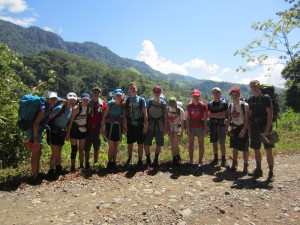 I can honestly say that the Duke of Ed Gold trip to Costa Rica was one of the best experiences of my life. I got to push my limits, I learned how much I was capable of leaving my comfort zone, I made some awesome new friends and participated in so many incredible activities that I never dreamed I could really do.
I can honestly say that the Duke of Ed Gold trip to Costa Rica was one of the best experiences of my life. I got to push my limits, I learned how much I was capable of leaving my comfort zone, I made some awesome new friends and participated in so many incredible activities that I never dreamed I could really do.

